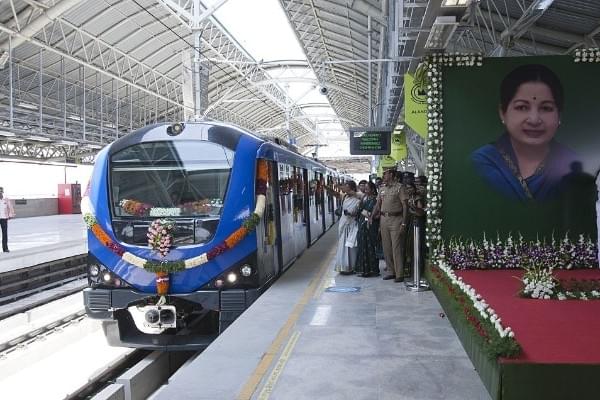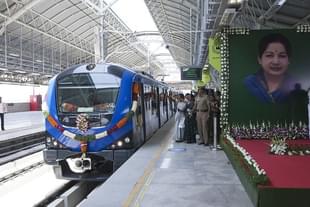Insta
Work On 120 Km Chennai Metro Phase II Begins By Early 2020, To Be Operational By 2026; Station Size Reduced
Swarajya Staff
Apr 29, 2019, 01:41 PM | Updated 01:41 PM IST
Save & read from anywhere!
Bookmark stories for easy access on any device or the Swarajya app.


The phase-II of the Chennai Metro is likely to become operational by 2026, Times of India reported.
The construction work for phase-2 project of Chennai Metro Rail spanning around 120 km is set to commence by end of this year or by early 2020. Of the total 120 km, 76.3 km will be elevated and rest will be built underground.
The Chennai Metro Rail Limited (CMRL) is likely to invite bids for phase-II of Chennai Metro Rail by June or July.
Once the tendering process is over, the construction is likely to begin in January or a couple of months later.
The phase-II of Chennai metro project, which is estimated to cost around Rs 69,180 crore, will have 128 metro stations. The total land requirement for this phase is estimated to be 120.98 hectares.
It will comprise of 3 Corridors -Madhavaram to SIPCOT (45.8 km), Light House to Poonamallee (26.1 km) and Madhavaram to Sholinganallur (47.0 km).
According to CMRL officials, the tenders for the construction of 52.01 km priority corridor will be taken up first, and is expected to begin by the end of 2019.
CMRL is currently conducting soil tests in several localities like a 66.8 km stretch, including Lighthouse, T Nagar and Poonamallee. It is likely to be completed by end of this year.
This 66.8 km stretch covers:
- 10 km from Sholinganallur to Siruseri Sipcot, along the OMR
- 26.1 km line from Lighthouse to Poonamallee linking several localities, including core areas like Mylapore, T Nagar, Kodambakkam and Vadapalani. It will also link Porur, Karayanchavadi, Iyyapanthangal and Poonamallee, which are poorly served by public transportation
- 30.7 km stretch is from CMBT to Sholinganallur, linking the western fringes of the city
To address the issue of spiralling land acquisition cost, CMRL has decided to bring down the average size of each metro station from 220 metres in the phase-1 to 150 metres in the phase-II.
According to CMRL officials, out of the land required for phase-II, around 93.79 hectares of land is government-owned and the remaining 27.19 hectares will be acquired from private owners.
Chennai Metro will need 1,309 properties, of which 104 are residential and the remaining 937 are commercial. The officials said the families and landowners will be adequately compensated.
CMRL also has decided to primarily use government land and ensure that a minimum number of people are affected. By predominantly using government land, CMRSL is hoping to avoid delays and cost overruns during land acquisition.





